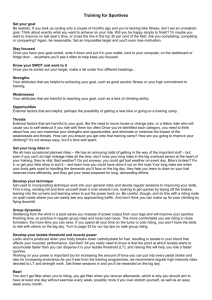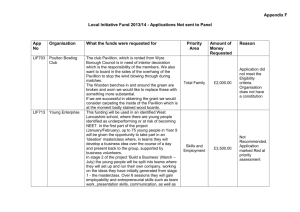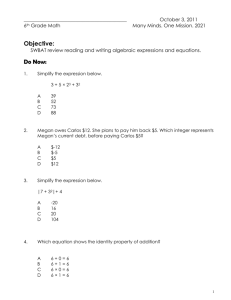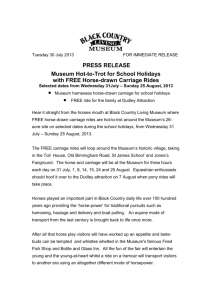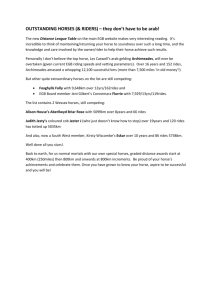National Museum of American History Freedom Rides Teacher Guide
advertisement
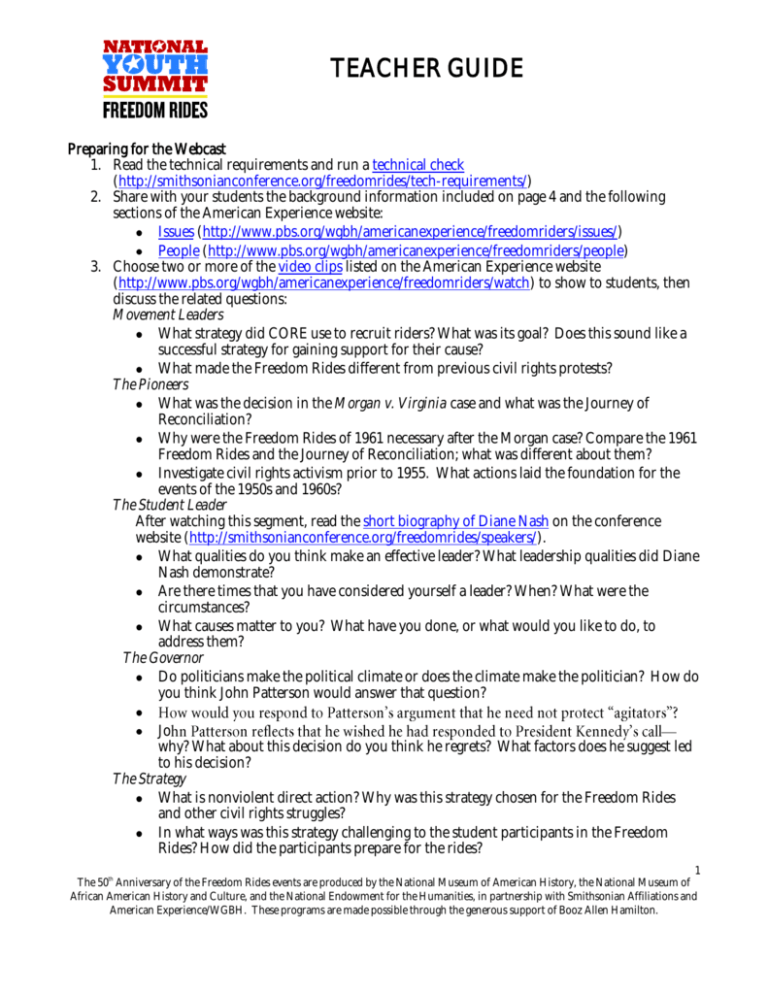
TEACHER GUIDE Preparing for the Webcast 1. Read the technical requirements and run a technical check (http://smithsonianconference.org/freedomrides/tech-requirements/) 2. Share with your students the background information included on page 4 and the following sections of the American Experience website: Issues (http://www.pbs.org/wgbh/americanexperience/freedomriders/issues/) People (http://www.pbs.org/wgbh/americanexperience/freedomriders/people) 3. Choose two or more of the video clips listed on the American Experience website (http://www.pbs.org/wgbh/americanexperience/freedomriders/watch) to show to students, then discuss the related questions: Movement Leaders What strategy did CORE use to recruit riders? What was its goal? Does this sound like a successful strategy for gaining support for their cause? What made the Freedom Rides different from previous civil rights protests? The Pioneers What was the decision in the Morgan v. Virginia case and what was the Journey of Reconciliation? Why were the Freedom Rides of 1961 necessary after the Morgan case? Compare the 1961 Freedom Rides and the Journey of Reconciliation; what was different about them? Investigate civil rights activism prior to 1955. What actions laid the foundation for the events of the 1950s and 1960s? The Student Leader After watching this segment, read the short biography of Diane Nash on the conference website (http://smithsonianconference.org/freedomrides/speakers/). What qualities do you think make an effective leader? What leadership qualities did Diane Nash demonstrate? Are there times that you have considered yourself a leader? When? What were the circumstances? What causes matter to you? What have you done, or what would you like to do, to address them? The Governor Do politicians make the political climate or does the climate make the politician? How do you think John Patterson would answer that question? Jo why? What about this decision do you think he regrets? What factors does he suggest led to his decision? The Strategy What is nonviolent direct action? Why was this strategy chosen for the Freedom Rides and other civil rights struggles? In what ways was this strategy challenging to the student participants in the Freedom Rides? How did the participants prepare for the rides? 1 th The 50 Anniversary of the Freedom Rides events are produced by the National Museum of American History, the National Museum of African American History and Culture, and the National Endowment for the Humanities, in partnership with Smithsonian Affiliations and American Experience/WGBH. These programs are made possible through the generous support of Booz Allen Hamilton. TEACHER GUIDE The Strategy, cont. What other strategies were employed by civil rights movement leaders, in addition to nonviolence, in order to advocate and gain support for their cause? The Music What was the purpose of singing freedom songs? In what way might singing protest songs reflect the overall strategies of the movement? The Exchange Student Why do you think white students were targeted for attack during the Freedom Rides? How did Jim Zwerg sustain himself in the face of violence and the lack of support he received from his parents? What did Jim Zwerg gain by his decision to be an exchange student? The Inspiration Why was the model of nonviolence practiced by Gandhi attractive to civil rights leaders? Was nonviolence universally accepted among civil rights activists as the model for responding to the conditions in the South? What were the arguments for and against nonviolence? that racial segregation on buses and trains was unconstitutional. However, only 24% agreed with the Freedom Rides. Why do you think that was? 4. Examine the biographies of each of the speakers (http://smithsonianconference.org/freedomrides/speakers/). Ask students to explain what perspective each participant might bring to this program. For those with some background knowledge about the Freedom Rides, discuss who else you might have liked to hear speak and why. 5. Review the post-webcast suggested activity, and prepare students by explaining the final project. 6. Find additional resources on the civil rights movement and the Freedom Rides from the following sources: (www.historyexplorer.si.edu) EDSITEment (http://edsitement.neh.gov/) Verizon Thinkfinity (http://thinkfinity.org/freedom-rides-50th-anniversary) (resources coming in Feb. 2011) (http://www.pbs.org/wgbh/americanexperience/freedomriders/teachers-guide) Please email thinkfinity@si.edu with questions about the guide or preparing students for the webcast. National Standards for History from the National Center for History in the Schools United States History Standards; Era 9: Postwar United States (1945 to early 1970s); Standard 4: The struggle for racial and gender equality and the extension of civil liberties Historical Thinking Standard 3: Historical Analysis and Interpretation; B. Consider multiple perspectives. Historical Thinking Standard 4: Historical Research Capabilities; A. Formulate historical questions. 2 th The 50 Anniversary of the Freedom Rides events are produced by the National Museum of American History, the National Museum of African American History and Culture, and the National Endowment for the Humanities, in partnership with Smithsonian Affiliations and American Experience/WGBH. These programs are made possible through the generous support of Booz Allen Hamilton. TEACHER GUIDE Freedom Rides Background Information Sheet In 1961, civil rights activists organized by the Congress of Racial Equality rode interstate buses into the segregated southern United States to test the United States Supreme Court decision Boynton v. Virginia (of 1960), which had outlawed racial segregation in restaurants and waiting rooms in terminals serving buses that crossed state lines. Five years prior to the Boynton ruling, the Interstate Commerce Commission (ICC) had issued a ruling in Sarah Keys v. Carolina Coach Company that had explicitly denounced the Plessy v. Ferguson doctrine of separate but equal in interstate bus travel, but the ICC had failed to enforce its own ruling, and thus Jim Crow travel laws remained in force throughout the South. The Freedom Riders set out to challenge this status quo by riding various forms of public transportation in the South to challenge local laws or customs that enforced segregation. From May until November 1961, more than 400 Americans rode south together on the Freedom Rides. The Riders were young and old, male and female, black, white, and Asian, religious and secular, and from the south, north, east and west of the nation. Unlike many protests in the Movement, the Riders were not practicing civil disobedience. They were doing exactly what the Supreme Court said they had a right to do. Freedom Riders bought tickets on buses and trains and traveled into the South, sitting wherever they pleased, as was their right. They knew, however, that Southern segregationists could be counted upon to violate their civil rights, forcing a conflict between the states and the federal government and demanding that an apathetic nation consider the inequality they exposed. The Freedom Riders also knew that this simple act of riding on a bus or train, in violation of a long-held and violently enforced tradition of white supremacy, might very well cost them their lives. They were beaten, bombed, harassed, and imprisoned but they changed the Civil Rights Movement and demonstrated the power of individual action to transform the nation. 3 th The 50 Anniversary of the Freedom Rides events are produced by the National Museum of American History, the National Museum of African American History and Culture, and the National Endowment for the Humanities, in partnership with Smithsonian Affiliations and American Experience/WGBH. These programs are made possible through the generous support of Booz Allen Hamilton. TEACHER GUIDE After the Program Create a video that responds to the content of the National Youth Summit on the Freedom Rides. Directions: Teachers and students should create a 3-5 minute video that responds to one of the prompts below. Completed videos may then be uploaded to YouTube, and the link sent to thinkfinity@si.edu. Submissions will be added to a playlist created by the National Museum of American History, and selected videos will be featured in the newsletter and on its Facebook page (http://www.facebook.com/americanhistory) and Twitter feeds (@amhistorymuseum and @explorehistory) beginning in early May. Submissions should be posted by April 30 to receive consideration for distribution by the National Museum of American History. Guidelines and Restrictions: Please see the terms of use for content to be included on the communication channels (http://www.si.edu/termsofuse/). Note that anyone submitting material to the site must be at least 13 years of age. Video Topics: Option 1: Reflection Create a video montage of students reflecting on any of the questions below, based on their participation in the National Youth Summit program and webcast. The video should include at least one student, and can include as many as is appropriate for your class or school. What was the most important lesson you took from the panel discussion? What did the Freedom Rides accomplish, broadly speaking? What issue today matters to you? What would you do to address it? What is the importance of civic engagement? How do you participate in public life? Option 2: Local History Create a video interview with people in your community who were alive during the civil rights movement or who were active in it. Topics to discuss could include their thoughts on the time period and their activism, including reasons they became involved or not, and their thoughts about the life choices afterward. Be sure to ask them to reflect on the methods used by the Freedom Riders. Or, examine a civil rights protest or related event in your area that occurred around 1961, and consider the following: The practice of active, nonviolent civic engagement during the event. The degree of local sympathy, civil unrest, or apathy, if any, associated with it. Any changes that occurred immediately or soon after the event. For recommendations on conducting oral histories, see the section on oral history in Examining Primary Sources with Students (pages 44-45: http://historyexplorer.si.edu/PrimarySources.pdf). 4 th The 50 Anniversary of the Freedom Rides events are produced by the National Museum of American History, the National Museum of African American History and Culture, and the National Endowment for the Humanities, in partnership with Smithsonian Affiliations and American Experience/WGBH. These programs are made possible through the generous support of Booz Allen Hamilton.
